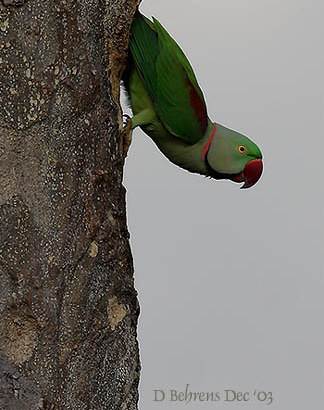| Kingdom: Animalia Phylum: Chordata Class: Aves (Birds) Order: Psittaciformes Family: Psittacidae | |
 Alexandrine Parakeet (Psittacula eupatria) - photo by David Behrens
Identification: Male - General plumage green. Rose-pink collar. Purple patch on wings. Tail: green, tipped with yellow. Beak: red with a paler tip. Pale yellow eyes. Green-grey legs. Female - Duller than male. No pink collar. Shorter tail. Juvenile - Similar to female. Call: Screams and screeches. Distribution: India, Sri Lanka, Afghanistan, western Pakistan, and Andaman Islands. Common in Northern India. In Sri Lanka numbers are declining and this parrot is now rare. Large flocks common on the Andaman Islands. Prefer woodland and forest, coconut plantations and trees in parks and gardens. Habits: At dusk large flocks arrive at their roost, usually a grove of trees. At dawn small groups leave for their feeding areas, screeching loudly. Fly high and in formation, travel long distances to feed. Fly fast with rhythmic wing beats. Food: Seeds, nuts, fruits, berries, blossoms, leaf buds and nectar. Damage crops such as wheat, rice, maize and fruit in orchards. Breeding: December - April. Nest - Lined with decayed wood. May be a crevice in a wall, under a roof or in a hollow tree. Often use holes made by other birds such as woodpeckers or create holes in softwood trees. Several pairs may nest in a tree. Eggs - 2-4, incubated by male and female for 28 days after last egg laid. Chicks - Leave the nest approximately 7 weeks after hatching. Males do not have adult plumage until they are 3 years old. | |
 birding.in
birding.in
| Birds | Bird Diagram | Ornithology | Indian Sites | Bird Watching | Migration | North India | Birds of India | Haryana |
All rights reserved. Copyright © 2005-2013 Birds and birding in India. Disclaimer
website: Free Java Guide & Tutorials